Reflective Report: Experience in Public Health Services - Caregiving
VerifiedAdded on 2021/05/12
|9
|2484
|59
Report
AI Summary
This report provides a reflective analysis of a student's experience as a caregiver in a residential care facility, focusing on the practical skills and organizational structures within public health services. The report details an incident involving inappropriate continent pad sizes, leading to increased workload and compromised patient care. It applies Gibbs' and Kolb's reflective cycles to analyze the situation, exploring feelings, evaluations, and action plans. The report emphasizes the importance of multidisciplinary working and the application of praxis in nursing, highlighting the need for confidence, assertiveness, and continuous professional development to improve patient outcomes and uphold the duty of care. The conclusion stresses the significance of social interaction with patients and the need for ongoing training to address emerging healthcare issues.
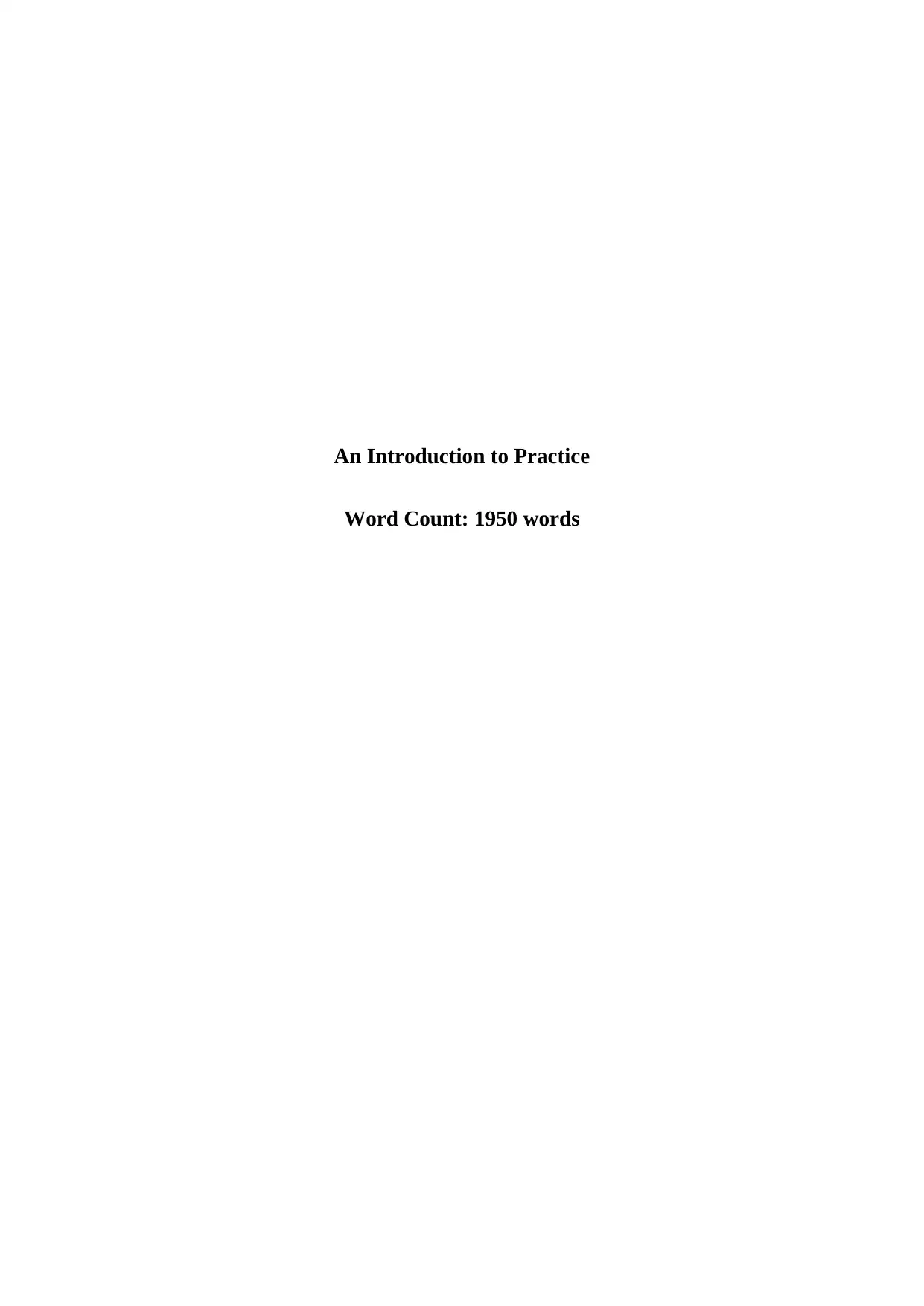
An Introduction to Practice
Word Count: 1950 words
Word Count: 1950 words
Paraphrase This Document
Need a fresh take? Get an instant paraphrase of this document with our AI Paraphraser
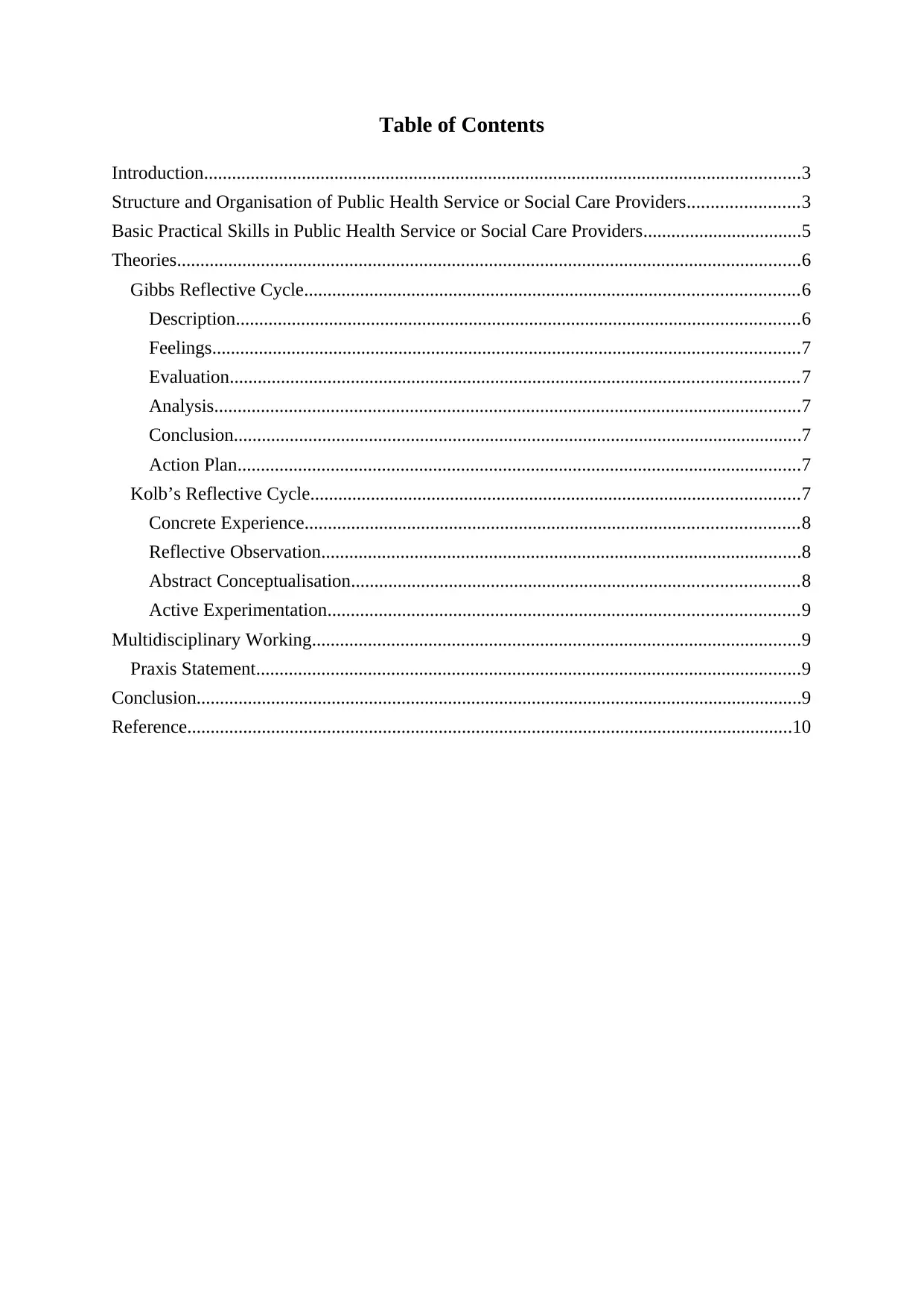
Table of Contents
Introduction................................................................................................................................3
Structure and Organisation of Public Health Service or Social Care Providers........................3
Basic Practical Skills in Public Health Service or Social Care Providers..................................5
Theories......................................................................................................................................6
Gibbs Reflective Cycle..........................................................................................................6
Description.........................................................................................................................6
Feelings..............................................................................................................................7
Evaluation..........................................................................................................................7
Analysis..............................................................................................................................7
Conclusion..........................................................................................................................7
Action Plan.........................................................................................................................7
Kolb’s Reflective Cycle.........................................................................................................7
Concrete Experience..........................................................................................................8
Reflective Observation.......................................................................................................8
Abstract Conceptualisation................................................................................................8
Active Experimentation.....................................................................................................9
Multidisciplinary Working.........................................................................................................9
Praxis Statement.....................................................................................................................9
Conclusion..................................................................................................................................9
Reference..................................................................................................................................10
Introduction................................................................................................................................3
Structure and Organisation of Public Health Service or Social Care Providers........................3
Basic Practical Skills in Public Health Service or Social Care Providers..................................5
Theories......................................................................................................................................6
Gibbs Reflective Cycle..........................................................................................................6
Description.........................................................................................................................6
Feelings..............................................................................................................................7
Evaluation..........................................................................................................................7
Analysis..............................................................................................................................7
Conclusion..........................................................................................................................7
Action Plan.........................................................................................................................7
Kolb’s Reflective Cycle.........................................................................................................7
Concrete Experience..........................................................................................................8
Reflective Observation.......................................................................................................8
Abstract Conceptualisation................................................................................................8
Active Experimentation.....................................................................................................9
Multidisciplinary Working.........................................................................................................9
Praxis Statement.....................................................................................................................9
Conclusion..................................................................................................................................9
Reference..................................................................................................................................10
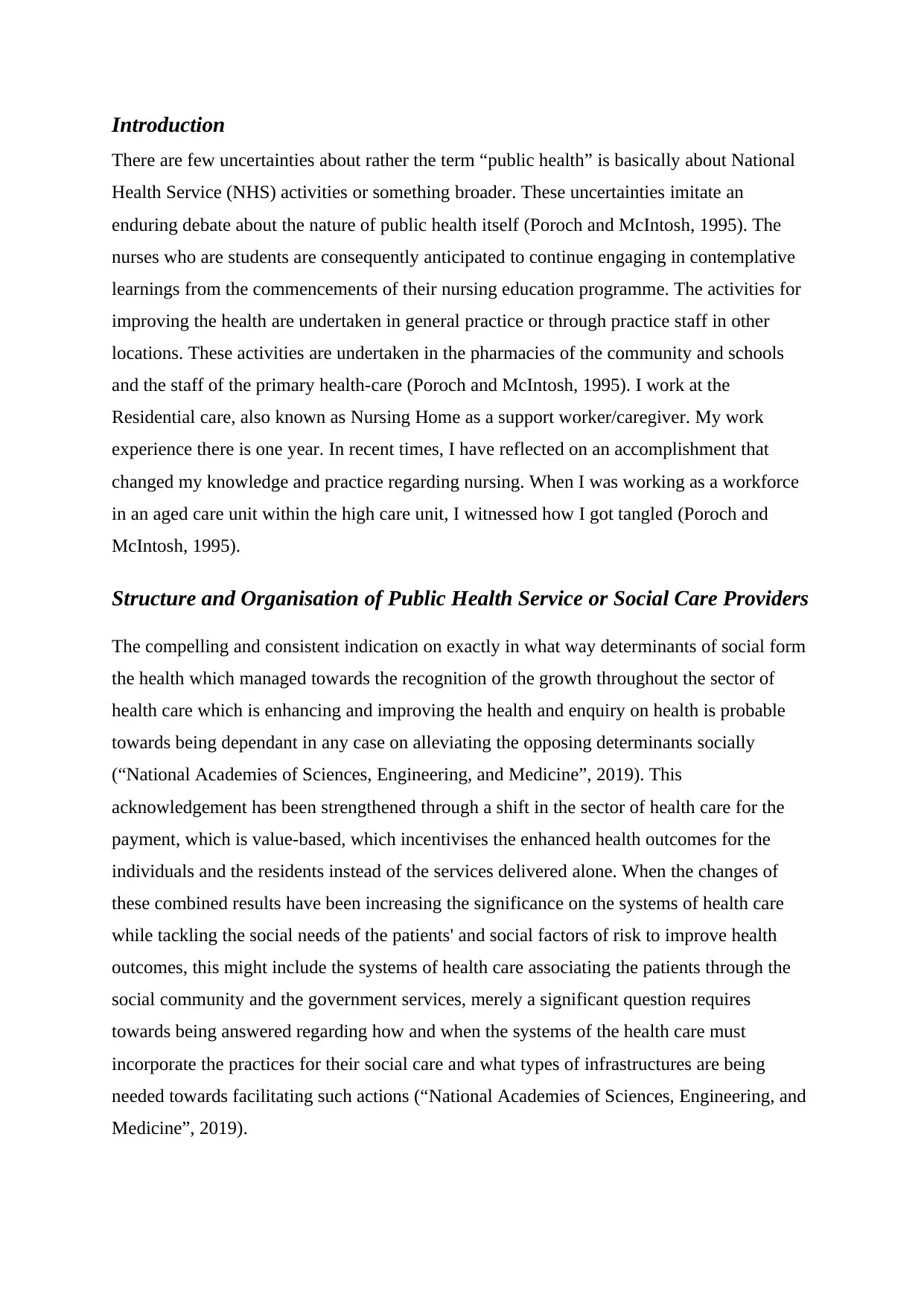
Introduction
There are few uncertainties about rather the term “public health” is basically about National
Health Service (NHS) activities or something broader. These uncertainties imitate an
enduring debate about the nature of public health itself (Poroch and McIntosh, 1995). The
nurses who are students are consequently anticipated to continue engaging in contemplative
learnings from the commencements of their nursing education programme. The activities for
improving the health are undertaken in general practice or through practice staff in other
locations. These activities are undertaken in the pharmacies of the community and schools
and the staff of the primary health-care (Poroch and McIntosh, 1995). I work at the
Residential care, also known as Nursing Home as a support worker/caregiver. My work
experience there is one year. In recent times, I have reflected on an accomplishment that
changed my knowledge and practice regarding nursing. When I was working as a workforce
in an aged care unit within the high care unit, I witnessed how I got tangled (Poroch and
McIntosh, 1995).
Structure and Organisation of Public Health Service or Social Care Providers
The compelling and consistent indication on exactly in what way determinants of social form
the health which managed towards the recognition of the growth throughout the sector of
health care which is enhancing and improving the health and enquiry on health is probable
towards being dependant in any case on alleviating the opposing determinants socially
(“National Academies of Sciences, Engineering, and Medicine”, 2019). This
acknowledgement has been strengthened through a shift in the sector of health care for the
payment, which is value-based, which incentivises the enhanced health outcomes for the
individuals and the residents instead of the services delivered alone. When the changes of
these combined results have been increasing the significance on the systems of health care
while tackling the social needs of the patients' and social factors of risk to improve health
outcomes, this might include the systems of health care associating the patients through the
social community and the government services, merely a significant question requires
towards being answered regarding how and when the systems of the health care must
incorporate the practices for their social care and what types of infrastructures are being
needed towards facilitating such actions (“National Academies of Sciences, Engineering, and
Medicine”, 2019).
There are few uncertainties about rather the term “public health” is basically about National
Health Service (NHS) activities or something broader. These uncertainties imitate an
enduring debate about the nature of public health itself (Poroch and McIntosh, 1995). The
nurses who are students are consequently anticipated to continue engaging in contemplative
learnings from the commencements of their nursing education programme. The activities for
improving the health are undertaken in general practice or through practice staff in other
locations. These activities are undertaken in the pharmacies of the community and schools
and the staff of the primary health-care (Poroch and McIntosh, 1995). I work at the
Residential care, also known as Nursing Home as a support worker/caregiver. My work
experience there is one year. In recent times, I have reflected on an accomplishment that
changed my knowledge and practice regarding nursing. When I was working as a workforce
in an aged care unit within the high care unit, I witnessed how I got tangled (Poroch and
McIntosh, 1995).
Structure and Organisation of Public Health Service or Social Care Providers
The compelling and consistent indication on exactly in what way determinants of social form
the health which managed towards the recognition of the growth throughout the sector of
health care which is enhancing and improving the health and enquiry on health is probable
towards being dependant in any case on alleviating the opposing determinants socially
(“National Academies of Sciences, Engineering, and Medicine”, 2019). This
acknowledgement has been strengthened through a shift in the sector of health care for the
payment, which is value-based, which incentivises the enhanced health outcomes for the
individuals and the residents instead of the services delivered alone. When the changes of
these combined results have been increasing the significance on the systems of health care
while tackling the social needs of the patients' and social factors of risk to improve health
outcomes, this might include the systems of health care associating the patients through the
social community and the government services, merely a significant question requires
towards being answered regarding how and when the systems of the health care must
incorporate the practices for their social care and what types of infrastructures are being
needed towards facilitating such actions (“National Academies of Sciences, Engineering, and
Medicine”, 2019).
⊘ This is a preview!⊘
Do you want full access?
Subscribe today to unlock all pages.

Trusted by 1+ million students worldwide
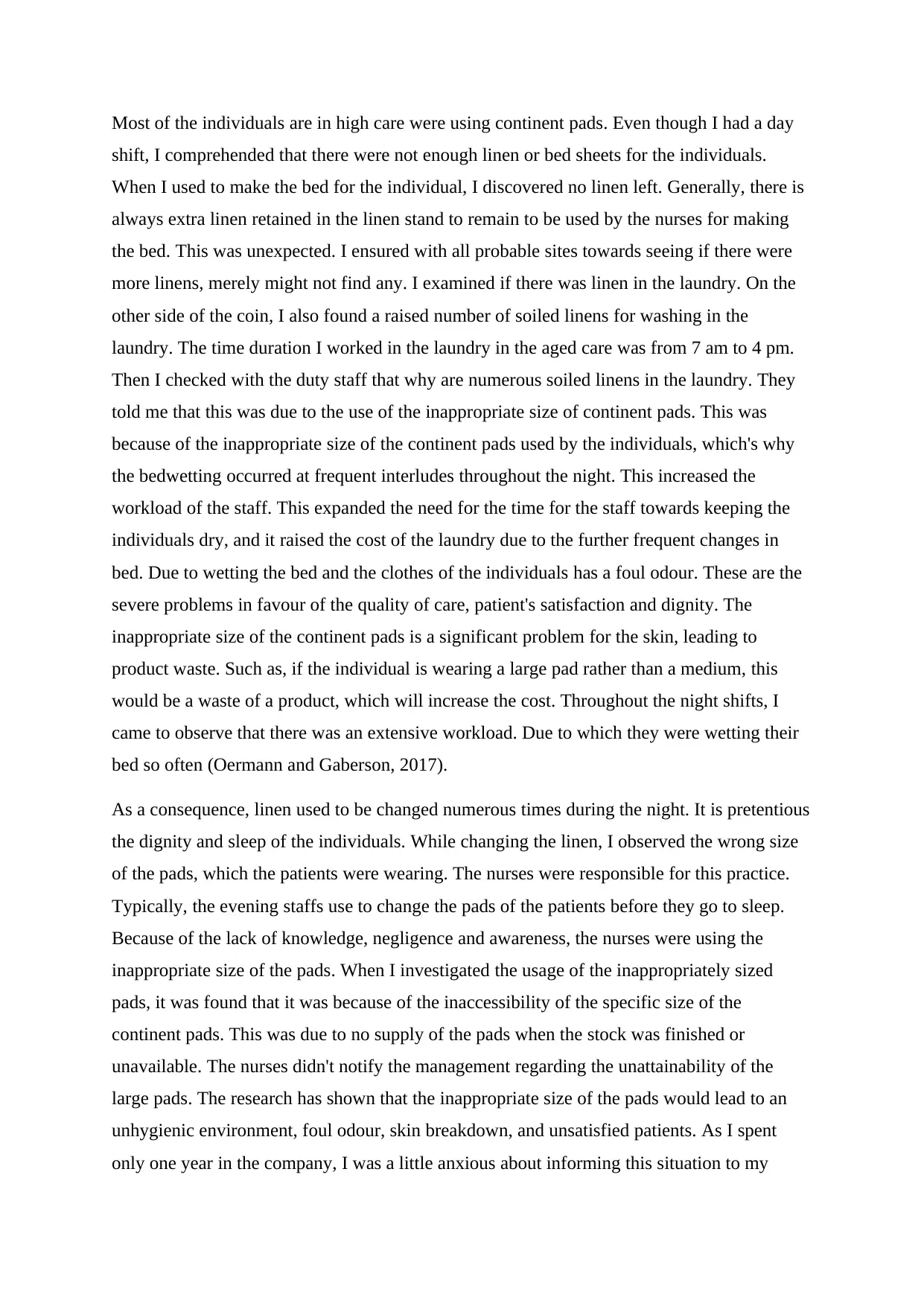
Most of the individuals are in high care were using continent pads. Even though I had a day
shift, I comprehended that there were not enough linen or bed sheets for the individuals.
When I used to make the bed for the individual, I discovered no linen left. Generally, there is
always extra linen retained in the linen stand to remain to be used by the nurses for making
the bed. This was unexpected. I ensured with all probable sites towards seeing if there were
more linens, merely might not find any. I examined if there was linen in the laundry. On the
other side of the coin, I also found a raised number of soiled linens for washing in the
laundry. The time duration I worked in the laundry in the aged care was from 7 am to 4 pm.
Then I checked with the duty staff that why are numerous soiled linens in the laundry. They
told me that this was due to the use of the inappropriate size of continent pads. This was
because of the inappropriate size of the continent pads used by the individuals, which's why
the bedwetting occurred at frequent interludes throughout the night. This increased the
workload of the staff. This expanded the need for the time for the staff towards keeping the
individuals dry, and it raised the cost of the laundry due to the further frequent changes in
bed. Due to wetting the bed and the clothes of the individuals has a foul odour. These are the
severe problems in favour of the quality of care, patient's satisfaction and dignity. The
inappropriate size of the continent pads is a significant problem for the skin, leading to
product waste. Such as, if the individual is wearing a large pad rather than a medium, this
would be a waste of a product, which will increase the cost. Throughout the night shifts, I
came to observe that there was an extensive workload. Due to which they were wetting their
bed so often (Oermann and Gaberson, 2017).
As a consequence, linen used to be changed numerous times during the night. It is pretentious
the dignity and sleep of the individuals. While changing the linen, I observed the wrong size
of the pads, which the patients were wearing. The nurses were responsible for this practice.
Typically, the evening staffs use to change the pads of the patients before they go to sleep.
Because of the lack of knowledge, negligence and awareness, the nurses were using the
inappropriate size of the pads. When I investigated the usage of the inappropriately sized
pads, it was found that it was because of the inaccessibility of the specific size of the
continent pads. This was due to no supply of the pads when the stock was finished or
unavailable. The nurses didn't notify the management regarding the unattainability of the
large pads. The research has shown that the inappropriate size of the pads would lead to an
unhygienic environment, foul odour, skin breakdown, and unsatisfied patients. As I spent
only one year in the company, I was a little anxious about informing this situation to my
shift, I comprehended that there were not enough linen or bed sheets for the individuals.
When I used to make the bed for the individual, I discovered no linen left. Generally, there is
always extra linen retained in the linen stand to remain to be used by the nurses for making
the bed. This was unexpected. I ensured with all probable sites towards seeing if there were
more linens, merely might not find any. I examined if there was linen in the laundry. On the
other side of the coin, I also found a raised number of soiled linens for washing in the
laundry. The time duration I worked in the laundry in the aged care was from 7 am to 4 pm.
Then I checked with the duty staff that why are numerous soiled linens in the laundry. They
told me that this was due to the use of the inappropriate size of continent pads. This was
because of the inappropriate size of the continent pads used by the individuals, which's why
the bedwetting occurred at frequent interludes throughout the night. This increased the
workload of the staff. This expanded the need for the time for the staff towards keeping the
individuals dry, and it raised the cost of the laundry due to the further frequent changes in
bed. Due to wetting the bed and the clothes of the individuals has a foul odour. These are the
severe problems in favour of the quality of care, patient's satisfaction and dignity. The
inappropriate size of the continent pads is a significant problem for the skin, leading to
product waste. Such as, if the individual is wearing a large pad rather than a medium, this
would be a waste of a product, which will increase the cost. Throughout the night shifts, I
came to observe that there was an extensive workload. Due to which they were wetting their
bed so often (Oermann and Gaberson, 2017).
As a consequence, linen used to be changed numerous times during the night. It is pretentious
the dignity and sleep of the individuals. While changing the linen, I observed the wrong size
of the pads, which the patients were wearing. The nurses were responsible for this practice.
Typically, the evening staffs use to change the pads of the patients before they go to sleep.
Because of the lack of knowledge, negligence and awareness, the nurses were using the
inappropriate size of the pads. When I investigated the usage of the inappropriately sized
pads, it was found that it was because of the inaccessibility of the specific size of the
continent pads. This was due to no supply of the pads when the stock was finished or
unavailable. The nurses didn't notify the management regarding the unattainability of the
large pads. The research has shown that the inappropriate size of the pads would lead to an
unhygienic environment, foul odour, skin breakdown, and unsatisfied patients. As I spent
only one year in the company, I was a little anxious about informing this situation to my
Paraphrase This Document
Need a fresh take? Get an instant paraphrase of this document with our AI Paraphraser
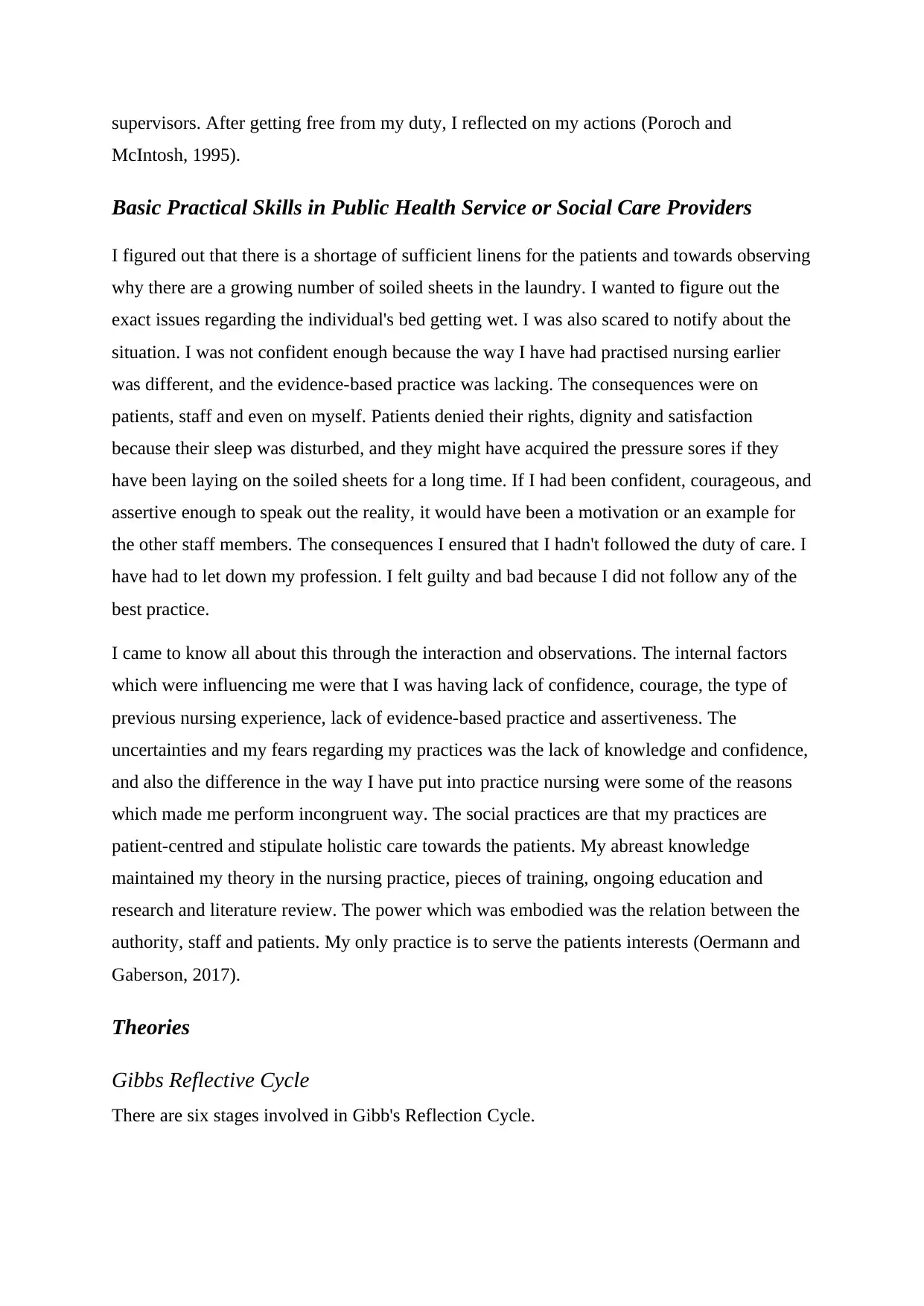
supervisors. After getting free from my duty, I reflected on my actions (Poroch and
McIntosh, 1995).
Basic Practical Skills in Public Health Service or Social Care Providers
I figured out that there is a shortage of sufficient linens for the patients and towards observing
why there are a growing number of soiled sheets in the laundry. I wanted to figure out the
exact issues regarding the individual's bed getting wet. I was also scared to notify about the
situation. I was not confident enough because the way I have had practised nursing earlier
was different, and the evidence-based practice was lacking. The consequences were on
patients, staff and even on myself. Patients denied their rights, dignity and satisfaction
because their sleep was disturbed, and they might have acquired the pressure sores if they
have been laying on the soiled sheets for a long time. If I had been confident, courageous, and
assertive enough to speak out the reality, it would have been a motivation or an example for
the other staff members. The consequences I ensured that I hadn't followed the duty of care. I
have had to let down my profession. I felt guilty and bad because I did not follow any of the
best practice.
I came to know all about this through the interaction and observations. The internal factors
which were influencing me were that I was having lack of confidence, courage, the type of
previous nursing experience, lack of evidence-based practice and assertiveness. The
uncertainties and my fears regarding my practices was the lack of knowledge and confidence,
and also the difference in the way I have put into practice nursing were some of the reasons
which made me perform incongruent way. The social practices are that my practices are
patient-centred and stipulate holistic care towards the patients. My abreast knowledge
maintained my theory in the nursing practice, pieces of training, ongoing education and
research and literature review. The power which was embodied was the relation between the
authority, staff and patients. My only practice is to serve the patients interests (Oermann and
Gaberson, 2017).
Theories
Gibbs Reflective Cycle
There are six stages involved in Gibb's Reflection Cycle.
McIntosh, 1995).
Basic Practical Skills in Public Health Service or Social Care Providers
I figured out that there is a shortage of sufficient linens for the patients and towards observing
why there are a growing number of soiled sheets in the laundry. I wanted to figure out the
exact issues regarding the individual's bed getting wet. I was also scared to notify about the
situation. I was not confident enough because the way I have had practised nursing earlier
was different, and the evidence-based practice was lacking. The consequences were on
patients, staff and even on myself. Patients denied their rights, dignity and satisfaction
because their sleep was disturbed, and they might have acquired the pressure sores if they
have been laying on the soiled sheets for a long time. If I had been confident, courageous, and
assertive enough to speak out the reality, it would have been a motivation or an example for
the other staff members. The consequences I ensured that I hadn't followed the duty of care. I
have had to let down my profession. I felt guilty and bad because I did not follow any of the
best practice.
I came to know all about this through the interaction and observations. The internal factors
which were influencing me were that I was having lack of confidence, courage, the type of
previous nursing experience, lack of evidence-based practice and assertiveness. The
uncertainties and my fears regarding my practices was the lack of knowledge and confidence,
and also the difference in the way I have put into practice nursing were some of the reasons
which made me perform incongruent way. The social practices are that my practices are
patient-centred and stipulate holistic care towards the patients. My abreast knowledge
maintained my theory in the nursing practice, pieces of training, ongoing education and
research and literature review. The power which was embodied was the relation between the
authority, staff and patients. My only practice is to serve the patients interests (Oermann and
Gaberson, 2017).
Theories
Gibbs Reflective Cycle
There are six stages involved in Gibb's Reflection Cycle.
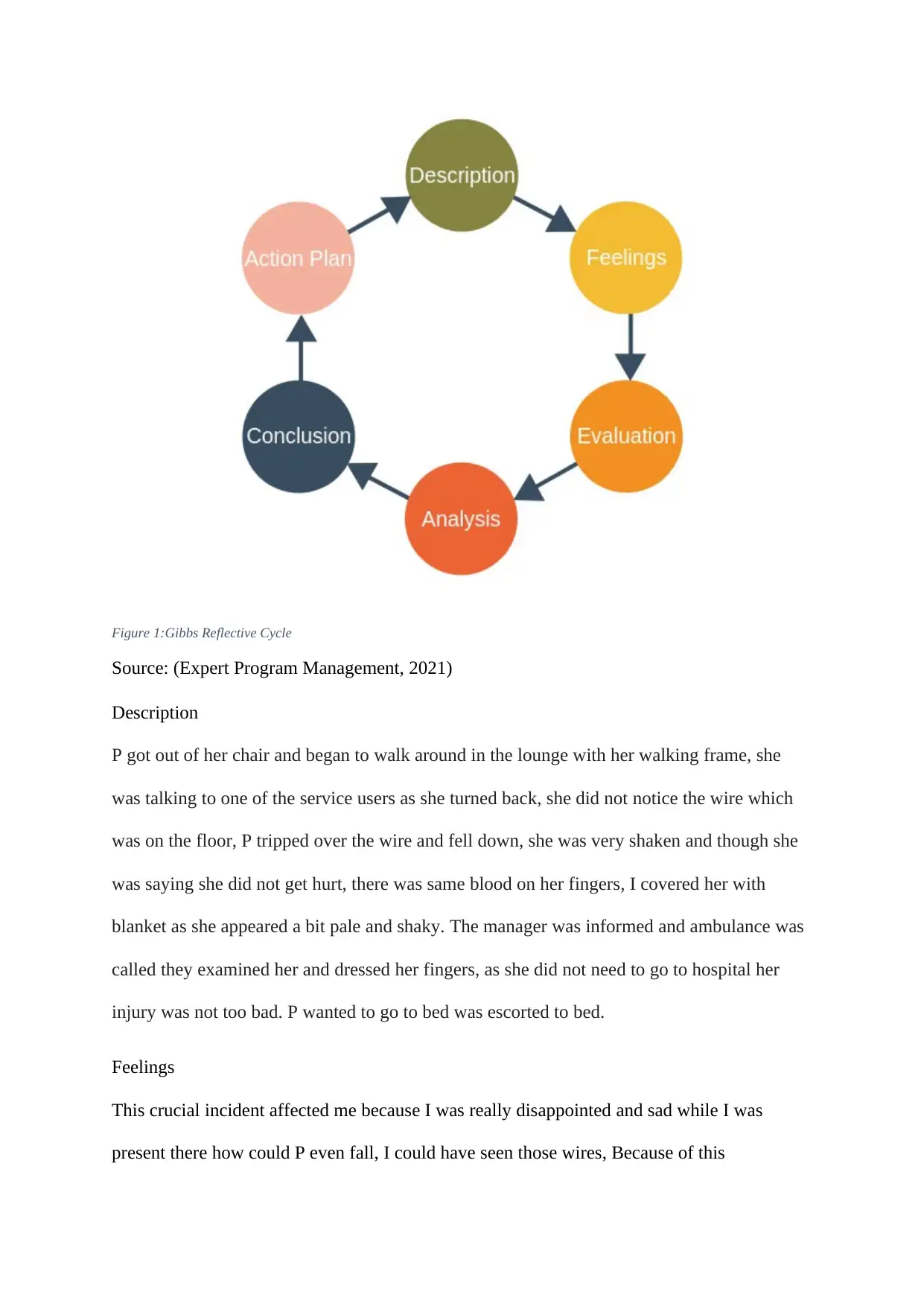
Figure 1:Gibbs Reflective Cycle
Source: (Expert Program Management, 2021)
Description
P got out of her chair and began to walk around in the lounge with her walking frame, she
was talking to one of the service users as she turned back, she did not notice the wire which
was on the floor, P tripped over the wire and fell down, she was very shaken and though she
was saying she did not get hurt, there was same blood on her fingers, I covered her with
blanket as she appeared a bit pale and shaky. The manager was informed and ambulance was
called they examined her and dressed her fingers, as she did not need to go to hospital her
injury was not too bad. P wanted to go to bed was escorted to bed.
Feelings
This crucial incident affected me because I was really disappointed and sad while I was
present there how could P even fall, I could have seen those wires, Because of this
Source: (Expert Program Management, 2021)
Description
P got out of her chair and began to walk around in the lounge with her walking frame, she
was talking to one of the service users as she turned back, she did not notice the wire which
was on the floor, P tripped over the wire and fell down, she was very shaken and though she
was saying she did not get hurt, there was same blood on her fingers, I covered her with
blanket as she appeared a bit pale and shaky. The manager was informed and ambulance was
called they examined her and dressed her fingers, as she did not need to go to hospital her
injury was not too bad. P wanted to go to bed was escorted to bed.
Feelings
This crucial incident affected me because I was really disappointed and sad while I was
present there how could P even fall, I could have seen those wires, Because of this
⊘ This is a preview!⊘
Do you want full access?
Subscribe today to unlock all pages.

Trusted by 1+ million students worldwide
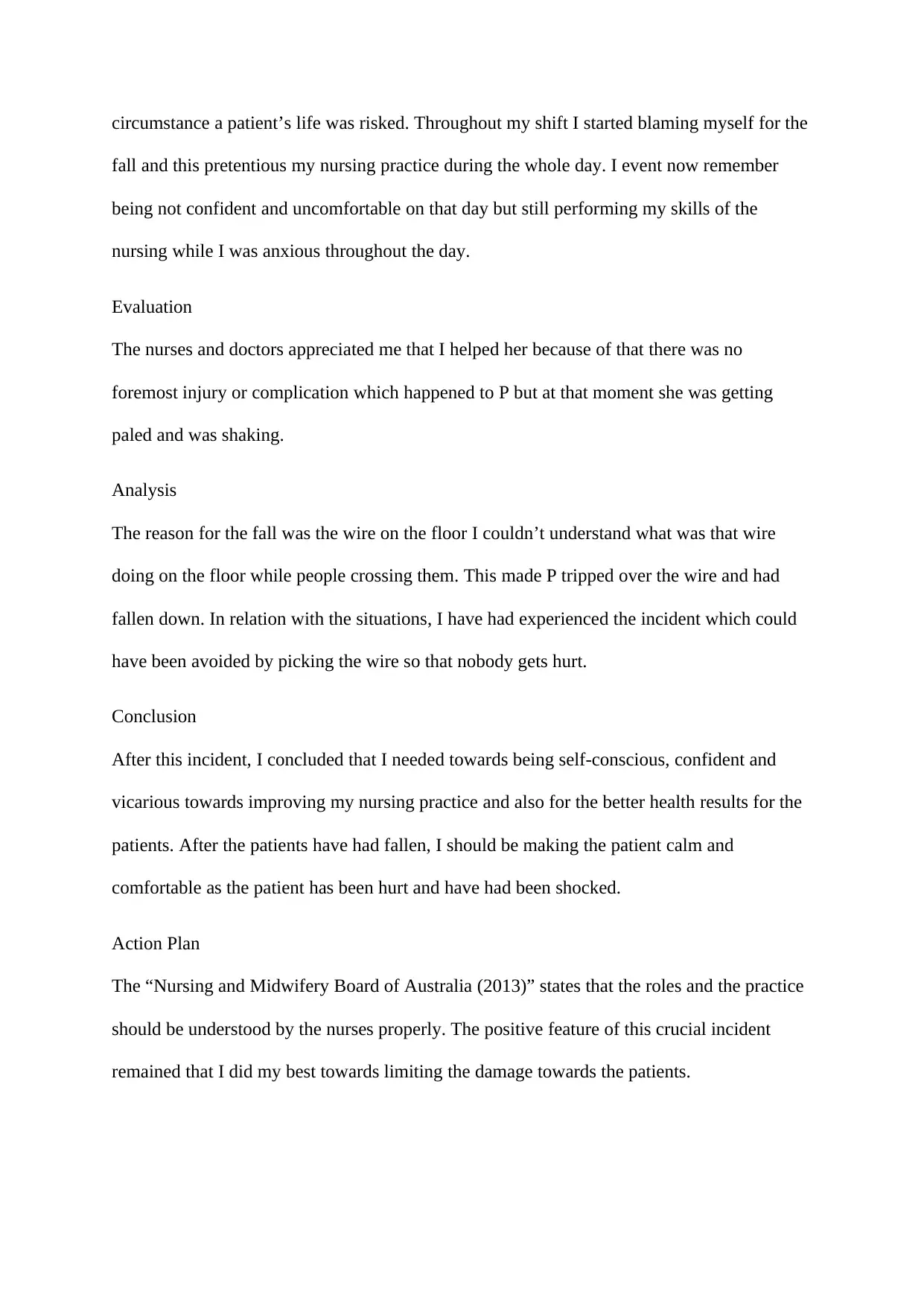
circumstance a patient’s life was risked. Throughout my shift I started blaming myself for the
fall and this pretentious my nursing practice during the whole day. I event now remember
being not confident and uncomfortable on that day but still performing my skills of the
nursing while I was anxious throughout the day.
Evaluation
The nurses and doctors appreciated me that I helped her because of that there was no
foremost injury or complication which happened to P but at that moment she was getting
paled and was shaking.
Analysis
The reason for the fall was the wire on the floor I couldn’t understand what was that wire
doing on the floor while people crossing them. This made P tripped over the wire and had
fallen down. In relation with the situations, I have had experienced the incident which could
have been avoided by picking the wire so that nobody gets hurt.
Conclusion
After this incident, I concluded that I needed towards being self-conscious, confident and
vicarious towards improving my nursing practice and also for the better health results for the
patients. After the patients have had fallen, I should be making the patient calm and
comfortable as the patient has been hurt and have had been shocked.
Action Plan
The “Nursing and Midwifery Board of Australia (2013)” states that the roles and the practice
should be understood by the nurses properly. The positive feature of this crucial incident
remained that I did my best towards limiting the damage towards the patients.
fall and this pretentious my nursing practice during the whole day. I event now remember
being not confident and uncomfortable on that day but still performing my skills of the
nursing while I was anxious throughout the day.
Evaluation
The nurses and doctors appreciated me that I helped her because of that there was no
foremost injury or complication which happened to P but at that moment she was getting
paled and was shaking.
Analysis
The reason for the fall was the wire on the floor I couldn’t understand what was that wire
doing on the floor while people crossing them. This made P tripped over the wire and had
fallen down. In relation with the situations, I have had experienced the incident which could
have been avoided by picking the wire so that nobody gets hurt.
Conclusion
After this incident, I concluded that I needed towards being self-conscious, confident and
vicarious towards improving my nursing practice and also for the better health results for the
patients. After the patients have had fallen, I should be making the patient calm and
comfortable as the patient has been hurt and have had been shocked.
Action Plan
The “Nursing and Midwifery Board of Australia (2013)” states that the roles and the practice
should be understood by the nurses properly. The positive feature of this crucial incident
remained that I did my best towards limiting the damage towards the patients.
Paraphrase This Document
Need a fresh take? Get an instant paraphrase of this document with our AI Paraphraser
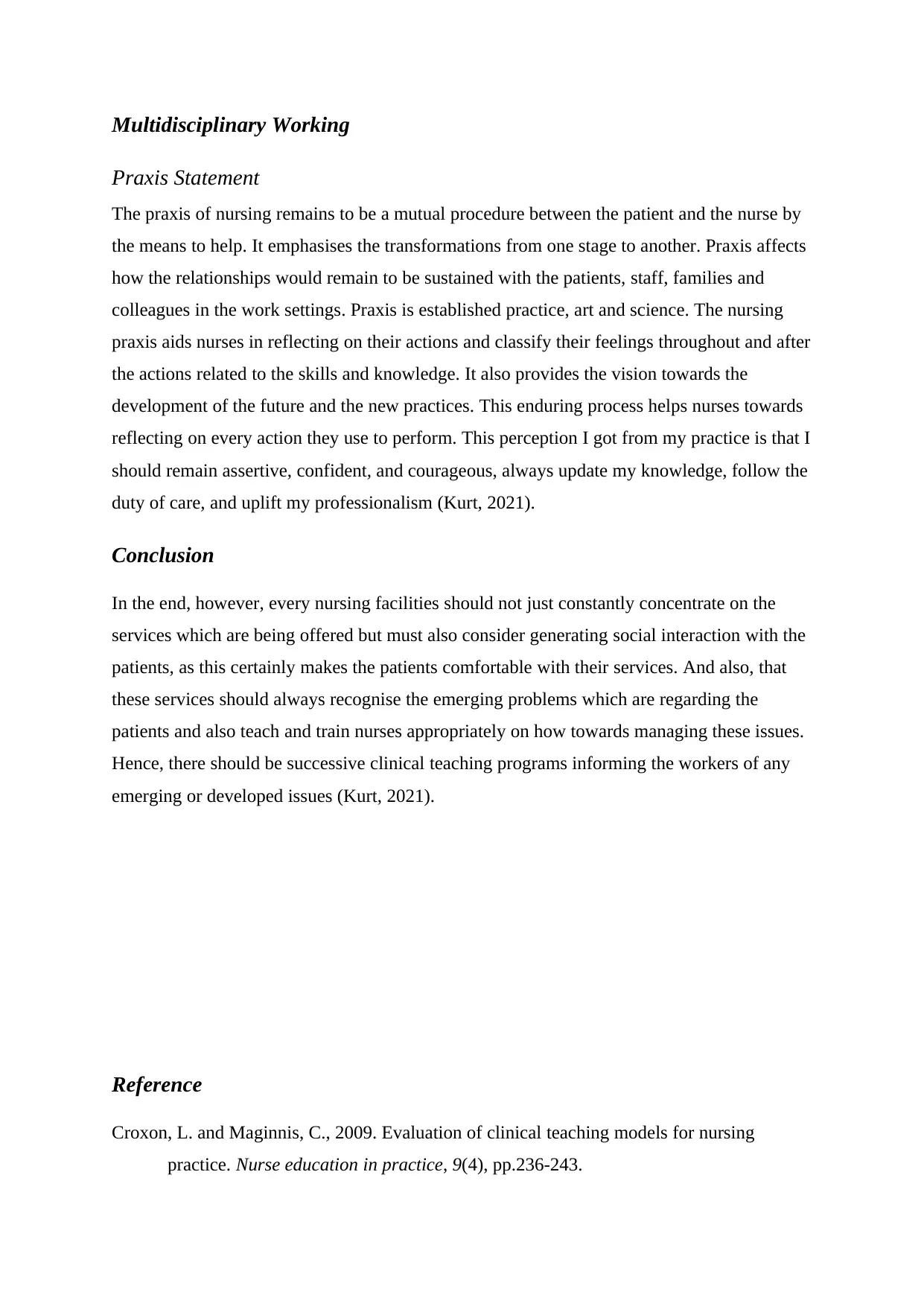
Multidisciplinary Working
Praxis Statement
The praxis of nursing remains to be a mutual procedure between the patient and the nurse by
the means to help. It emphasises the transformations from one stage to another. Praxis affects
how the relationships would remain to be sustained with the patients, staff, families and
colleagues in the work settings. Praxis is established practice, art and science. The nursing
praxis aids nurses in reflecting on their actions and classify their feelings throughout and after
the actions related to the skills and knowledge. It also provides the vision towards the
development of the future and the new practices. This enduring process helps nurses towards
reflecting on every action they use to perform. This perception I got from my practice is that I
should remain assertive, confident, and courageous, always update my knowledge, follow the
duty of care, and uplift my professionalism (Kurt, 2021).
Conclusion
In the end, however, every nursing facilities should not just constantly concentrate on the
services which are being offered but must also consider generating social interaction with the
patients, as this certainly makes the patients comfortable with their services. And also, that
these services should always recognise the emerging problems which are regarding the
patients and also teach and train nurses appropriately on how towards managing these issues.
Hence, there should be successive clinical teaching programs informing the workers of any
emerging or developed issues (Kurt, 2021).
Reference
Croxon, L. and Maginnis, C., 2009. Evaluation of clinical teaching models for nursing
practice. Nurse education in practice, 9(4), pp.236-243.
Praxis Statement
The praxis of nursing remains to be a mutual procedure between the patient and the nurse by
the means to help. It emphasises the transformations from one stage to another. Praxis affects
how the relationships would remain to be sustained with the patients, staff, families and
colleagues in the work settings. Praxis is established practice, art and science. The nursing
praxis aids nurses in reflecting on their actions and classify their feelings throughout and after
the actions related to the skills and knowledge. It also provides the vision towards the
development of the future and the new practices. This enduring process helps nurses towards
reflecting on every action they use to perform. This perception I got from my practice is that I
should remain assertive, confident, and courageous, always update my knowledge, follow the
duty of care, and uplift my professionalism (Kurt, 2021).
Conclusion
In the end, however, every nursing facilities should not just constantly concentrate on the
services which are being offered but must also consider generating social interaction with the
patients, as this certainly makes the patients comfortable with their services. And also, that
these services should always recognise the emerging problems which are regarding the
patients and also teach and train nurses appropriately on how towards managing these issues.
Hence, there should be successive clinical teaching programs informing the workers of any
emerging or developed issues (Kurt, 2021).
Reference
Croxon, L. and Maginnis, C., 2009. Evaluation of clinical teaching models for nursing
practice. Nurse education in practice, 9(4), pp.236-243.
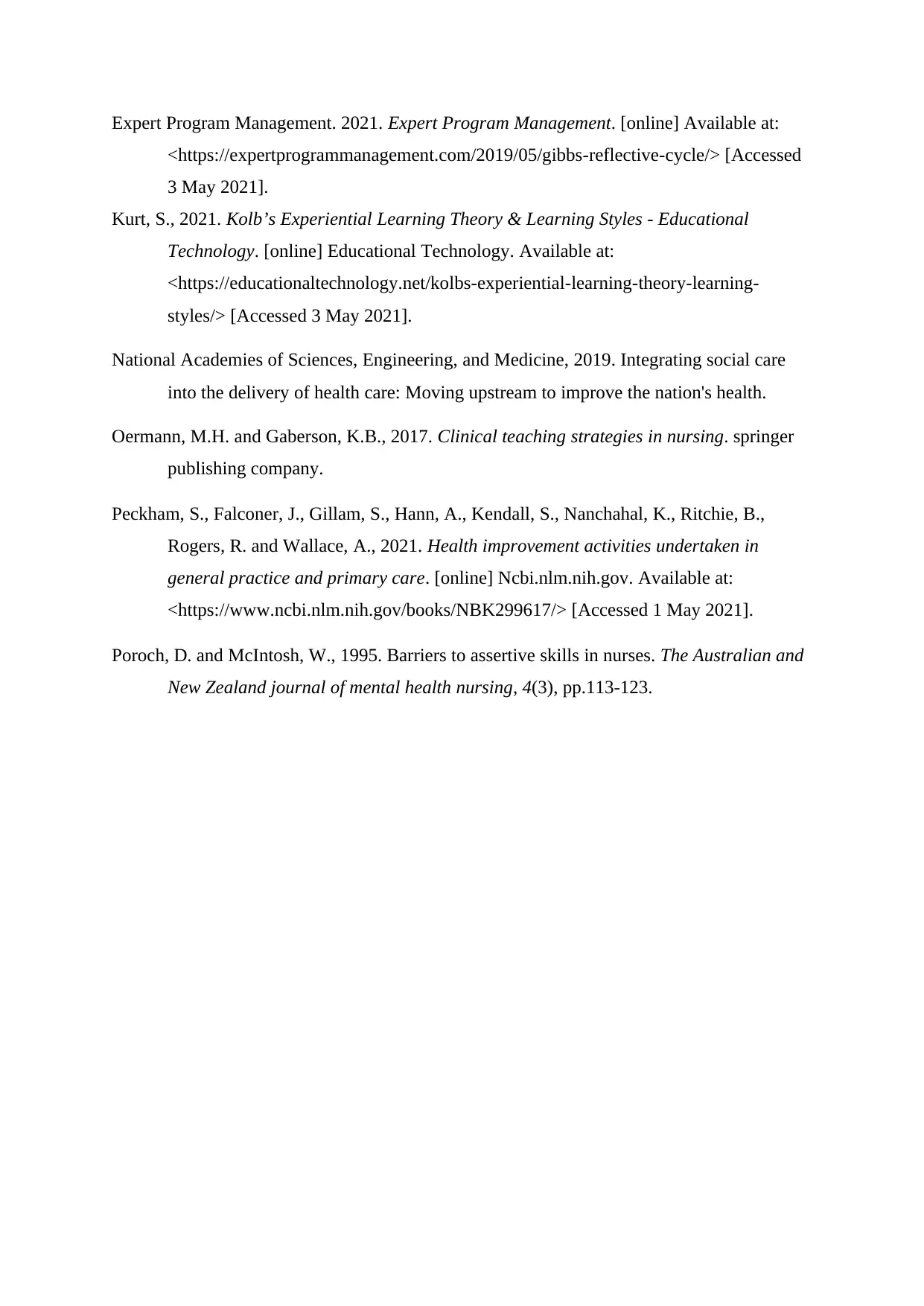
Expert Program Management. 2021. Expert Program Management. [online] Available at:
<https://expertprogrammanagement.com/2019/05/gibbs-reflective-cycle/> [Accessed
3 May 2021].
Kurt, S., 2021. Kolb’s Experiential Learning Theory & Learning Styles - Educational
Technology. [online] Educational Technology. Available at:
<https://educationaltechnology.net/kolbs-experiential-learning-theory-learning-
styles/> [Accessed 3 May 2021].
National Academies of Sciences, Engineering, and Medicine, 2019. Integrating social care
into the delivery of health care: Moving upstream to improve the nation's health.
Oermann, M.H. and Gaberson, K.B., 2017. Clinical teaching strategies in nursing. springer
publishing company.
Peckham, S., Falconer, J., Gillam, S., Hann, A., Kendall, S., Nanchahal, K., Ritchie, B.,
Rogers, R. and Wallace, A., 2021. Health improvement activities undertaken in
general practice and primary care. [online] Ncbi.nlm.nih.gov. Available at:
<https://www.ncbi.nlm.nih.gov/books/NBK299617/> [Accessed 1 May 2021].
Poroch, D. and McIntosh, W., 1995. Barriers to assertive skills in nurses. The Australian and
New Zealand journal of mental health nursing, 4(3), pp.113-123.
<https://expertprogrammanagement.com/2019/05/gibbs-reflective-cycle/> [Accessed
3 May 2021].
Kurt, S., 2021. Kolb’s Experiential Learning Theory & Learning Styles - Educational
Technology. [online] Educational Technology. Available at:
<https://educationaltechnology.net/kolbs-experiential-learning-theory-learning-
styles/> [Accessed 3 May 2021].
National Academies of Sciences, Engineering, and Medicine, 2019. Integrating social care
into the delivery of health care: Moving upstream to improve the nation's health.
Oermann, M.H. and Gaberson, K.B., 2017. Clinical teaching strategies in nursing. springer
publishing company.
Peckham, S., Falconer, J., Gillam, S., Hann, A., Kendall, S., Nanchahal, K., Ritchie, B.,
Rogers, R. and Wallace, A., 2021. Health improvement activities undertaken in
general practice and primary care. [online] Ncbi.nlm.nih.gov. Available at:
<https://www.ncbi.nlm.nih.gov/books/NBK299617/> [Accessed 1 May 2021].
Poroch, D. and McIntosh, W., 1995. Barriers to assertive skills in nurses. The Australian and
New Zealand journal of mental health nursing, 4(3), pp.113-123.
⊘ This is a preview!⊘
Do you want full access?
Subscribe today to unlock all pages.

Trusted by 1+ million students worldwide
1 out of 9
Related Documents
Your All-in-One AI-Powered Toolkit for Academic Success.
+13062052269
info@desklib.com
Available 24*7 on WhatsApp / Email
![[object Object]](/_next/static/media/star-bottom.7253800d.svg)
Unlock your academic potential
Copyright © 2020–2025 A2Z Services. All Rights Reserved. Developed and managed by ZUCOL.





